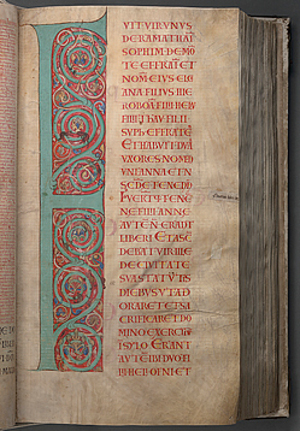

The manuscript includes illuminations in red, blue, yellow, green and gold.

It is unknown who removed the pages or for what purpose but it seems likely that they contained the monastic rules of the Benedictines. It initially contained 320 sheets, though some of these were subsequently removed. Weighing 74.8 kg (165 lb), Codex Gigasis composed of 310 leaves of vellum allegedly made from the skins of 160 donkeys or perhaps calfskin. At 92 cm (36 in) tall, 50 cm (20 in) wide and 22 cm (8.7 in) thick, it is the largest known medieval manuscript. The codex’s bookbinding is wooden boards covered with leather, and then ornate metal guards and fittings. Very large illuminated bibles were a typical feature of Romanesque monastic book production, but even within this group the page-size of the Codex Gigas is exceptional. Between the Old and New Testaments are a selection of other popular medieval reference works: Josephus’s Antiquities of the Jewsand De bello iudaico, Isidore of Seville’s encyclopedia Etymologiae, the chronicle of Cosmas of Prague, and medical works these are an early version of the Ars medicinaecompilation of treatises, and two books by Constantine the African.Įventually finding its way to the imperial library of Rudolf II in Prague, the entire collection was taken as war booty by the Swedish in 1648 during the Thirty Years’ War, and the manuscript is now preserved at the National Library of Sweden in Stockholm, although it is no longer on display for the general public. It contains the complete Vulgate Bible as well as other popular works, all written in Latin. It was created in the early 12th century in the Benedictine monastery of Podlažice in Bohemia (modern Czech Republic). It is also known as the Devil’s Biblebecause of a very unusual full-page portrait of the devil, and the legend surrounding its creation.

The Codex Gigas(English: Giant Book) is probably the largest extant medieval illuminated manuscript in the world, at 92 cm (36 in) tall.


 0 kommentar(er)
0 kommentar(er)
